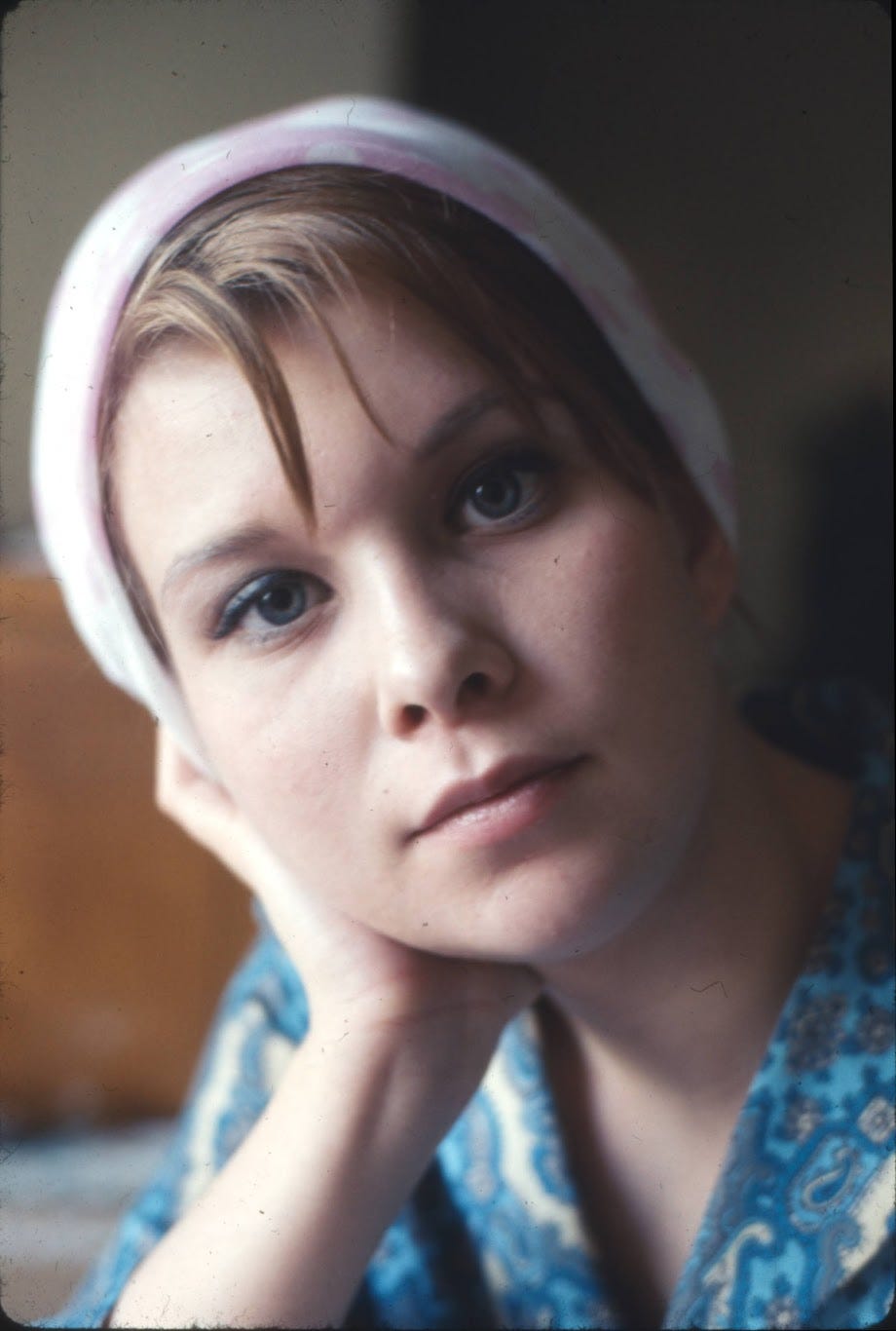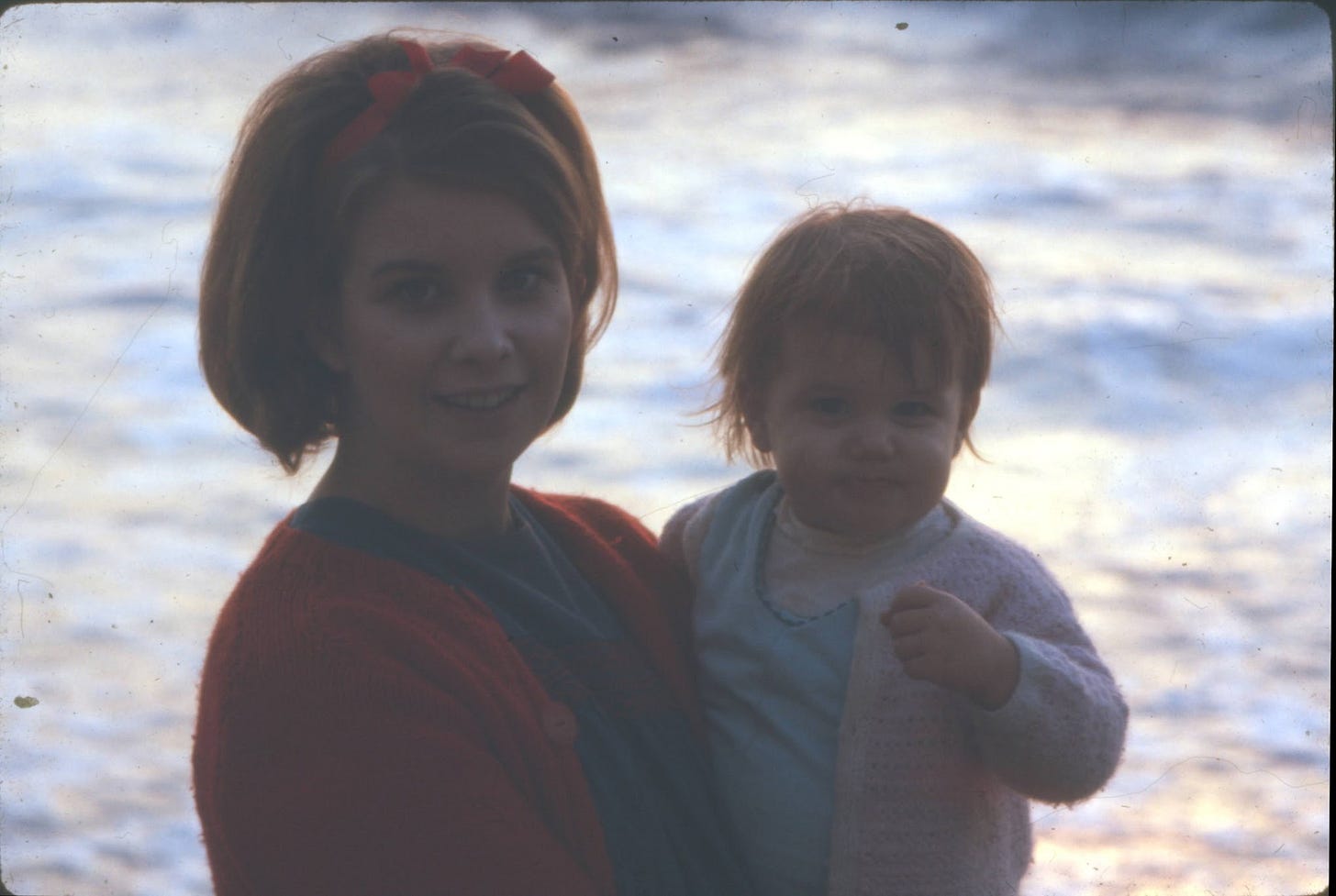This is a very lightly edited version of the talk I gave at my mother’s memorial service.
Memorial Service for Luise Marie Ybright
12 July 2025, Citrus Heights, California
Traditionally at LDS funerals, the final speaker attempts to frame death with a faith-based perspective, a sort of spiritual “batting clean-up,” as it were. In our discussions about what she wanted to have happen at her funeral, my mother charged me specifically with this task, so I’ve been thinking about it for months. At first, it seemed an impossible assignment.
Why? Though she grew up in The Church of Jesus Christ of Latter-day Saints, at the end of her life, my mother did not characterize herself as a believer. Last November, she confessed to me that it was hard to believe in an afterlife because she couldn’t imagine it. “When I try to visualize it,” she said, “All I see is a blank, white wall.”
“That sounds like the veil,” I replied, meaning the LDS concept of the veil placed between our mortal minds and our memories of pre-earth life as spirit children with Heavenly Parents. “I don’t think we’re meant to see beyond that wall while we’re still here.” But my answer did not satisfy her.
I mentioned this conversation to my friend Jenna. Jenna’s take: “Won’t she be happily surprised!”
“I’m not sure it’ll be a happy surprise,” I said. “My mother hates surprises, and she doesn’t enjoy being wrong. But who does, after all?”
What could I say to you all, then, that would be true to her memory, to myself, and to her siblings, children, and other loved ones, who represent a wonderfully diverse spectrum of beliefs? It took serious reflection on my part.
But my mother appreciated effort, and I’m sure would be delighted at how much longer and harder I’ve worked on this talk than I did when faced with the identical job at my father’s funeral twelve years ago. However, as I thought about my mother’s life, I put pieces of a puzzle together.
From jigsaw puzzles of famous paintings, to Chopin waltzes, to a flawlessly executed arabesque or curveball, to everything about birds, my mother craved Beauty. When I was a little girl, she kept her favorite book, Annie Dillard’s Pulitzer Prize-winning Pilgrim at Tinker Creek, on her nightstand just under her scriptures. For years, because of where it lived, I assumed the book was scripture. Once I was old enough to appreciate it, I realized why it was her favorite book; it’s one of the most Beauty-filled pieces of prose ever crafted in the English language. In chapter 7, Dillard ponders the concept of beauty itself:
Today I watched and heard a wren, a sparrow, and the mockingbird singing. My brain started to trill why why why, what is the meaning meaning meaning? It’s not that they know something we don’t; we know much more than they do, and surely they don’t even know why they sing. No; we have been as usual asking the wrong question. It does not matter a hoot what the mockingbird on the chimney is singing. If the mockingbird were chirping to give us the long-sought formulae for a unified field theory, the point would be only slightly less irrelevant.
The real and proper question is: Why is it beautiful? I hesitate to use the word so baldly, but the question is there. The question is there since I take it as given, as I have said, that beauty is something objectively performed—the tree that falls in the forest—having been externally, stumbled across or missed, as real and present as both sides of the mood. This modified lizard’s song welling out of the fireplace has a wild, utterly foreign music; it becomes more and more beautiful as it becomes more and more familiar.
If the lyric is simply ‘mine mine mine,’ then why the extravagance of the score? It has the liquid, intricate sound of every creek’s tumble over every configuration of rock creek-bottom in the country. Who, telegraphing a message, would trouble to transmit a five-act play, or Coleridge’s ‘Kubla Khan,’ and who, receiving the message, could understand it?
Beauty itself is the language to which we have no key; it is the mute cipher, the cryptogram, the uncracked, unbroken code. And it could be that for beauty…that there is no key, that [it] will never make sense in our own language but only in its own, and that we need to start all over again, on a new continent, learning the strange syllables one by one. (Annie Dillard, Pilgrim at Tinker Creek)
Perhaps reading this excerpt you see why Pilgrim at Tinker Creek was a text my mother returned to over and over again. Beauty was something concrete that gave her a sense of control when the circumstances of her life seemed beyond her control; it gave her difficult life meaning.
Because it was, my mother found, a difficult life. Fatherless at age 14, husbandless at age 25 and again at 34, she did what it took to survive. Through all of the battles and exhaustion and worry, she made time for and spent scant resources on Beauty; it was perhaps her one constant. Her piano was her true best friend, her most trusted confidante; we kids knew never to interrupt when they were in conversation.
And as she lay dying, she may not have known what was to come. In the face of fear and uncertainty, as she had all her life, I know she took deep comfort in what she could sense: her copy of Hokusai’s woodblock print The Great Wave off Kanagawa, in remembering great books and music, and in caressing the butter-soft Italian leather gloves kept in tissue paper in her top left dresser drawer.
This, then, is one answer to Dillard’s question: Why is it beautiful? The Divine uses the interaction of Beauty with our physical senses to communicate with us. A children’s song my mother loved to play on the piano talks about bird song, the blue, blue sky, the touch of a velvet rose—all sending us love from the Powers in the Universe that created us—and the way our gratitude sends a humble answer.
The essayist Julia Christina wrote,
Beauty is the essence of the universe, and the experience of beauty is love. Presence is the experience of Nature’s beauty. Hence, presence is love. And that is how only love is real. (Julia Christina, The Journey, 11 July 2025)
I’m graced to be here in the room with my own spectacular children—one or more of whom will likely speak at my own funeral at some point in what I hope is the far-distant future. I make no stipulations, but I also make no promises. But I invite them and everyone else to consider the patterns of generations, the way history can rhyme, and the messages Beauty can send us.
When our beloved Grandma Ybright lay paralyzed after a series of strokes, my mother would beg her, “Please, come and visit me after you die. Let me know you’re all right.” Though Grandma was unable to speak, my mother told me she felt sure she’d agreed to the repeated request. But in the weeks and months after Grandma died, there was no visit; my mother was crushed. I believe that’s when her faith, which had faltered for years, finally died.
My sisters and I could never bring ourselves to tell her that the exact moment our Grandma died, the three of us in three different states and time zones had identical visions of Grandma’s sweet laughing face wreathed in white light. We kept it to ourselves for 25 years, all agreeing our mother would have felt betrayed and offended and horribly excluded. For the same reason, I could never share with her that seven years later, the night before my youngest child was born, Grandma visited me in a dream.
She came into my hospital room, beautiful in her trademark sensible shoes, polyester slacks, and colorful, stain-resistant blouse. She sat on the edge of my bed and gave me sound advice about mothering this new child. After a few minutes, she smiled, patted my hand, stood, and left. It is a precious memory—but it gutted me that I couldn’t share it with my mother. She would have been furious.
As it was, racked with secret guilt, I argued with my mother about Grandma’s promise. Maybe she was sending subtle messages? A goldfinch on a windowsill; a rare orchid in a shop window; a lenticular cloud formation; a favorite old song chanced upon on the radio. But perhaps precisely because my father saw signs everywhere—on license plates, in magazine ads, through the names of television sit-com characters—my mother was more exacting in her definition of what constituted a manifestation from the beyond.
As of today, I have had no vision or dream of my mother. However. The blackbirds and robins and swifts in the trees around our little house in France sing liberally at all hours of the day and night. Scrawled in spray paint on a wall along a walk I take nearly daily are the words “On est né pour briller”: “We are born to shine,” a phrase I know my mother would have found lovely. And when I smell Chanel No. 5, it’s like she’s in the room with me. Beauty is a language of the Spirit that communicates the Divine.
The prophet Alma declared,
All things denote there is a God; yea, even the earth, and all things that are on the face of it, yea, and its motion, yea, and also all the planets which do move in their regular form do witness there is a Supreme Creator. (The Book of Mormon, Alma 30:44)
The great poet-priest Gerard Manley Hopkins agreed:
The world is charged with the grandeur of God.
It will flame out, like shining from shook foil;
It gathers to a greatness, like the ooze of oil
Crushed. Why do men then now not reck his rod?
Generations have trod, have trod, have trod;
And all is seared with trade; bleared, smeared with toil;
And wears man's smudge and shares man's smell: the soil
Is bare now, nor can foot feel, being shod.
And for all this, nature is never spent;
There lives the dearest freshness deep down things;
And though the last lights off the black West went
Oh, morning, at the brown brink eastward, springs —
Because the Holy Ghost over the bent
World broods with warm breast and with ah! bright wings.
(Gerard Manley Hopkins, “God’s Grandeur”)
Required Reading (A list compiled by Luise Ybright, an English teacher, before she died for her printed funeral program)
Pilgrim at Tinker Creek, by Annie Dillard
The Name of the Rose, by Umberto Eco
Whale Rider, by Witi Ihimaera
Gone with the Wind, by Margaret Mitchell
Hawaii, by James Michener
Night, by Elie Wiesel
The Things They Carried, by Tim O’Brien
The Orchardist, by Amanda Coplin
Still Life, by Louise Penny
My Name is Asher Lev, by Chaim Potok
To Kill a Mockingbird, by Harper Lee
Angle of Repose, by Wallace Stegner
My Antonia, by Willa Cather
Wild Geese, by Mary Oliver





A beautiful tribute. Wonderfully done, Luisa. ❤️